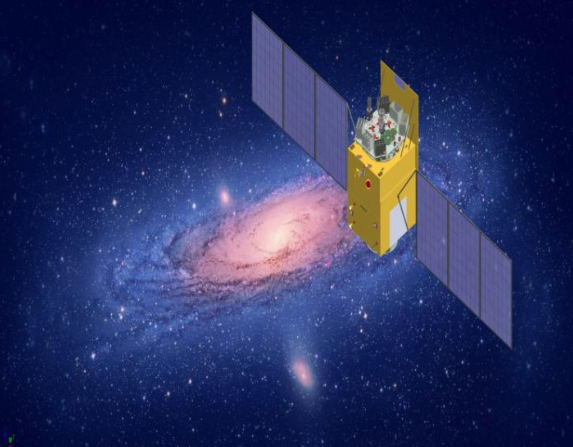China had a successful launch aboard a Long March 4B rocket of their first large space telescope, Hard X-ray Modulation Telescope (HXMT), at 11:00 on Thursday morning from Jiuquan, which will observe the X-ray emissions black holes, pulsars and gamma-ray bursts.
The 2,800 kg HXMT probe, also known as 'Huiyan' or 'Insight', carries three sets of detectors to collect highly energetic x-rays emitted by black holes, neutron stars and other phenomena across a range of 1-250 kiloelectron volts (keV). HXMT will also look for the electromagnetic counterparts to gravitational waves, which were first detected by LIGO in 2015, and gamma-ray bursts (GRBs) up to energies of 3,000 keV.

The Hard X-ray Modulation Telescope (HXMT) is shown in orbit.
Image by IHEP
It will orbit at an altitude of around 550 km, inclined by 43 degrees, where it will operate for at least four years, and the scientists at the Institute of High Energy Physics (IHEP) will learn about the properties of transient x-ray sources in great detail, as well as the circumstances in which emissions are generated.
Additionally, the satellite will explore the mechanisms of neutron stars and pulsar timing, that were provided from the XPNAV-1 satellite launched last autumn. The hope is that they will work in concert with the Five Hundred Meter Aperture Spherical Telescope (FAST) in Guizhou Province.
Chief designer Lu Fangjun, of the payload of HXMT, says the space telescope will focus on the Galactic plane. If it finds any celestial body in a state of explosion, it will conduct high-precision pointed observation and joint multiband observation with other telescopes either in space or on the ground.
Today's launch was originally supposed to launch in 2010, but a lack of funding delayed process. The mission finally went forward after being taken into the CAS Strategic Priority Program on Space Science.
The launch also carried the OVS-1a and 1b video satellites, an early part of the Chinese Orbita micro and nano satellite constellation, which will compose of four hyperspectral and 12 video satellites.
Also along for the ride was the 37 kg ÑuSat-3 (Milanesat) of Satellogic of Argentina, the third bird in the Aleph-1 constellation. The first two launched on another Long March 4B along with the Ziyuan-3-II remote sensing satellite in May 2016.

